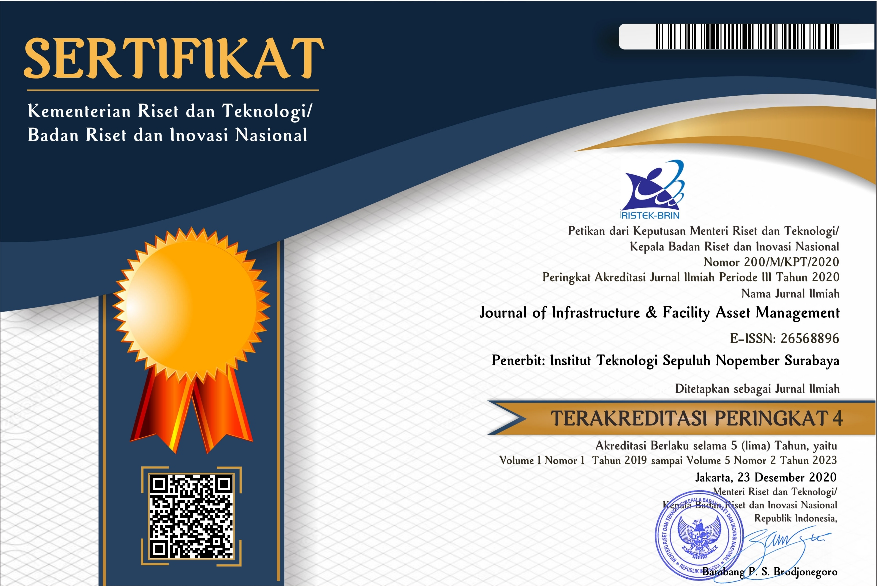The Other Sensory Approach on Exploring Urban Heritage Landscape. Case Study: Chinese Quarter of Semarang
Abstract
A new interpretation is needed to give meaning to conservation in the urban development framework and to support a sustainable cultural environment. Based on Québec Declaration (2008) and Burra Charter (2013), intangible dimensions became matter to give a richer and deeper meaning to the cultural heritage area. A shift has been seen in urban theories arguing for attention to the multi-sensory approach. This concept becomes matters as the raising critique towards the domination of visual perception in the built environment's design. The domination of audio-vision starting to reach out by the practitioners and scholars, unlike the other senses such as smell, tended to overlook and misconception. This paper outlines a pilot study's findings addressing holistic person-sensory experience in exploring the role of odor in shaping the cultural heritage area in Pecinan nowadays. It will discuss various scents detected, personal perception, and the link between odor and Pecinan's character. All this data was collected using a smells walk, questionnaire survey, and interview. This research aims to explore the potential interface in preservation conflict between the character of existing historic town and change as smellscape is part of the intangible element and part of triangle components of a sense of place in supporting successful urban place.
Full Text:
PDFReferences
Adrianne, A. A., & Dwirahmi, A. (2013). Pecinan Semarang: Sepenggal Kisah, Sebuah Perjalanan. Kepustakaan Populer Gramedia.
Bembibre, C., & Strlič, M. (2017). "Smell of heritage: A framework for the identification, analysis and archival of historic odors". Heritage Science, 5(1), 1–11. https://doi.org/10.1186/s40494-016-0114-1
Bently, I., Alcock, A., Murrain, P., McGlynn, S., & Smith, G. (1985). "Responsive environments. A manual for designers". In Elsevier Ltd. https://doi.org/10.1016/0169-2046(88)90064-3
Bruce, N., Condie, J., Henshaw, V., & Payne, S. R. (2015). "Analysing olfactory and auditory sensescapes in English cities: Sensory expectation and urban environmental perception". Ambiances, July 2015, 0–14. https://doi.org/10.4000/ambiances.560
Bubandt, N. (1998). "The odor of things: Smell and the cultural elaboration of disgust in Eastern Indonesia". Ethnos, 63(1), 48–80. https://doi.org/10.1080/00141844.1998.9981564
Buck, L., & Axel, R. (1991). A novel multigene family may encode odorant receptors. Society of General Physiologists Series, 65, 175–187.
Classen, C., Howes, D., & Synnott, A. (1994). Aroma: the cultural history of smell. Routledge. http://books.google.com/books?id=HmDIoCbZTzMC&pgis=1
Dowdey, S. (2020). How smell works – Fifth Sense. Howstuffworks. https://www.fifthsense.org.uk/how-smell-works-2/ (accessed 25 February 2020)
Engen, T. (1982). "The Perception of Odors. In Artificial Human Sensors". Academic Press, Inc. https://doi.org/10.1201/b11773-4
Engen, T., & Ross, B. M. (1973). "Long-term memory of odors with and without verbal descriptions". Journal of Experimental Psychology, 100(2), 221–227. https://doi.org/10.1037/h0035492
Erwine, B. (2016). "Creating Sensory Spaces: The Architecture of the Invisible". In Creating Sensory Spaces. https://doi.org/10.4324/9781315688282
Henshaw, V. (2013). "Urban smellscapes: Understanding and designing city smell environments". In Routledge. https://doi.org/10.4324/9780203072776
Henshaw, V., Mclean, K., Medway, D., Perkins, C., & Warnaby, G. (2018). Designing with Smell: Practice, Techniques, and Challenges. Routledge.
Henshaw, V., & Mould, O. T. (2013). "Sensing designed space: An exploratory methodology for investigating the human response to sensory environments". Journal of Design Research, 11(1), 57–71. https://doi.org/10.1504/JDR.2013.054066
ICOMOS. (2008). "Québec Declaration on the Preservation of the Spirit of Place". https://doi.org/10.1017/S0940739108080430
ICOMOS, A. (2013). "The Burra Charter: The Australia ICOMOS Charter for Places of Cultural Significance 2013". https://doi.org/10.1007/978-1-4419-0465-2_1046
Lynch, K. (1960). The Image of The City. The M.I.T. Press.
Martokusumo, W. (2001). "Heritage and Urban Conservation Some Notions on Post-Colonial". Urbanism in Search for Cultural Identity 1. August, 22–23.
Martokusumo, W., Poerbo, H.W., Sarwono, J., Sudarsono, A.S., & Putu, N. (2019). SOUNDCSAPE AND THE UNDERSTANDING. 371–380.
Mclean, K. (2019). NOSE-FIRST: Practices of smell walking and smellscape mapping. Royal College of Art.
Mclean, K., Christ, C., & Kingdom, U. (2020). "Sensory Mapping". In International Encyclopedia of Human Geography (Second Edi, Vol. 12). Elsevier. https://doi.org/10.1016/B978-0-08-102295-5.10592-X
Montgomery, J. (1998). "Making a city: urbanity, vitality, and urban design". Journal of Urban Design, 3(1), 93–116. https://doi.org/10.1080/13574809808724418
Pallasmaa, J. (2005). The Eyes of The Skin: Architecture and The Senses. John Wiley & Sons Ltd. http://arts.berkeley.edu/wp-content/uploads/2016/01/Pallasmaa_The-Eyes-of-the-Skin.pdf
Porteous, J. D. (1985). "Smellscape". Progress in Human Geography", 9(3), 356–378. https://doi.org/10.1177/030913258500900303
Quercia, D., Schifanella, R., Aiello, L. M., & McLean, K. (2015). "Smelly Maps: The digital life of urban smellscapes". Proceedings of the 9th International Conference on Web and Social Media, ICWSM 2015, Jacobs 1961, 327–336.
Re: Streets. (2020). Wayfinding. https://www.restreets.org/wayfinding#tab2 (accessed 31 May 2020)
Rodaway, P. (1994). Sensuous Geographies: body, sense, and place. In Routledge.
Saputra, G. (2018). Begini Sejarah Terbentuknya Pecinan di Kota Semarang. Bisnis.Com. https://semarang.bisnis.com/read/20180214/535/756923/begini-sejarah-terbentuknya-pecinan-di-kota-semarang (accessed 27 September 2020)
The Japan Times. (2001). Ministry compiles a list of the nation's 100 best-smelling spots. https://www.japantimes.co.jp/news/2001/10/31/national/ministry-compiles-list-of-nations-100-best-smelling-spots/ (accessed 13 August 2020)
Trevino, M. T. (2020). The people trying to save scents from extinction. BBC. https://www.bbc.com/future/article/20200108-why-preserving-certain-scents-is-important (accessed 15 August 2020)
UNESCO. (2009). HOI AN PROTOCOLS.
Xiao, J. (2018). "Smell, smellscape, and place-making: A review of approaches to study smellscape". In Handbook of Research on Perception-Driven Approaches to Urban Assessment and Design (pp. 240–258). https://doi.org/10.4018/978-1-5225-3637-6.ch010
Xiao, J., Tait, M., & Kang, J. (2018). "A perceptual model of smellscape pleasantness". Cities, 76(August 2017), 105–115. https://doi.org/10.1016/j.cities.2018.01.013
Xiao, J., Tait, M., & Kang, J. (2020). "Understanding smellscapes: Sense-making of smell-triggered emotions in place". Emotion, Space and Society, 37. https://doi.org/10.1016/j.emospa.2020.100710
Zardini, M. (2005). Sense of The City: an Alternate Approach to Urbanism. In Canadian Centre for Architecture and Lars Mu¨ller.
DOI: http://dx.doi.org/10.12962%2Fjifam.v3i3.14130
Refbacks
- There are currently no refbacks.
Visitor :
Flag Counter

Journal Of Infrastructure & Facility Asset Management by Institut Teknologi Sepuluh Nopember is licensed under a Creative Commons Attribution-ShareAlike 4.0 International License.





